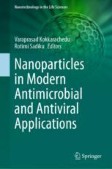Search
Search Results
-
Comparison of Multi-metallic Nanoparticles-Alternative Antibacterial Agent: Understanding the Role of Their Antibacterial Properties
The rise of antibiotic-resistant infectious diseases caused by various bacterial pathogens has emerged as a major global health concern. As a result,...

-
Crystallization, morphology, optical properties, tear properties and antibacterial properties of nano zinc oxide composites
Nanometer Zinc oxide (nano ZnO) composites are widely used in the packaging industry due to their excellent antibacterial properties. In this study,...

-
Synthesis, Characterization of Polyethylene Ionomers and Their Antibacterial Properties
Owing to its high production volume and wide range of applications, polyethylene has gained a great deal of attention, but its low surface energy and...
-
Preparation and antibacterial properties of polypropylene composite with bisphenol A-type benzoxazine
Polypropylene (PP) is a commonly used material in medical supplies. However, its lack of antibacterial properties has led to a frequent occurrence of...

-
Novel Synthetic Antibacterial Agents
Classical (fermentation-based) and nonclassical (nonfermentation-based) antibacterials are conventionally used for the treatment of bacterial...
-
Preparation, characterization and antibacterial properties of 4-aminocinnamic acid-modified cellulose fibers
Cellulose materials do not possess any inherent antibacterial properties, which greatly limits their application in medical and food packaging...

-
Tannin–Thioctic Acid Network Hydrogels with Antibacterial and Hydrophobic Properties
Making a multifunctional hydrogel-based wound dressing is a long-term research goal. Therefore, it is of great significance to develop an ideal wound...

-
Preparation and Properties of Water-Resistant Antibacterial Curcumin/Silver Composite Nanofiber
The water-resistant antibacterial PVA nanofibers containing curcumin (Cur) and silver nanoparticles (AgNPs) were prepared by electrospinning, and the...

-
Influence of Biochar on the Properties of Antibacterial PBAT/Carvacrol Films
In recent years, there has been an increasing interest in antibacterial biopolymeric films. Among the different approaches for tuning the release...

-
Ultra-tough poly(vinyl alcohol)/polydopamine/nanosilver nanocomposite films with enhanced antibacterial and antioxidant properties
The fabrication of ultra-tough biodegradable nanocomposite films with antibacterial activity and antioxidant properties remains a huge challenge....

-
Synthesis of imidazole derivatives and their immobilization to wool fabric to impart antibacterial properties
The increasing awareness of health and hygiene issues, coupled with epidemics and rising living standards, has fueled a growing interest and demand...

-
Sustainable Nanomaterials as Promising Antibacterial Agents
The use of sustainable nanoparticles (NPs) as antibiotic substitutes has grown in popularity for the elimination of germs. The treatment of bacterial...
-
The Role of Renewable Protocatechol Acid in Epoxy Coating Modification: Significantly Improved Antibacterial and Adhesive Properties
It is of great significance to design epoxy coatings with superior antibacterial properties and high adhesive properties, as well as excellent...
-
Evaluation of antibacterial properties of polyvinyl alcohol/chitosan/potassium permanganate electrospun nanofibers
This study aimed to investigate the antibacterial properties of polyvinyl alcohol/chitosan/potassium permanganate composite nanofibers in different...

-
MXene-Based Nanocomposites for Antibacterial Applications
The rise of antibiotic-resistant bacteria is a major concern for public health. To address this issue, there is a need to develop innovative...
-
Enhancing Antibacterial and Water-Repellent Properties for the Production of High-Performance Fabrics in Home Textiles
In this research, we aimed to enhance the antibacterial activity and water repellency functionalities of single-layer 100% cotton fabrics on both the...

-
Enhanced Mechanical and Barrier Properties of PVACINKS Cross-Linked Films for Antibacterial Food Packaging
AbstractThis study employed polyvinyl alcohol (PVA), cinnamaldehyde (CIN), and potassium sorbate (KS) as raw materials for the production of...

-
Preparation and properties of antibacterial composite hydrogels based on polyvinyl alcohol, chitosan, and nano-metal oxide
Hydrogels are effective wound dressings because of their capacity to promptly absorb wound exudate and maintain a moist environment for healing. In...

-
Study on the Effect of Chitosan Modification Technology on Antibacterial Properties of Textiles
The chitosan is fixed in an amide group of activated carboxyl groups and biological primary amino groups of nonwoven PET for antibacterial...

-
Studies on Photocatalytic Degradation for Organic Pollutants by TiO2/Au Composite and its Antibacterial Properties
AbstractTiO 2 /Au had been prepared readily from tetrabutyl titanate and chloroauric acid by in situ solvothermal method. SEM, XRD, UV-vis, FTIR, etc...

